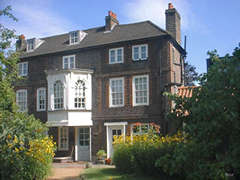Hogarth House Boosted By Tate Show
Visit to Chiswick treasure will illuminate main exhibition
|
An exhibition celebrating the life and work of the eighteenth century artist William Hogarth is drawing visitors has sparked renewed interest in the author's former home in Chiswick.
The exhibition currently on display at Tate Britain is the most comprehensive showing of his works in 30 years, and is proving popular with art lovers who are finding out more about Hogarth by visiting his Hogarth House.
Cllr Peter Thompson, leader of the London borough of Hounslow, said he hoped more people would combine a visit to the exhibition with a trip to Hogarth House as it provided a unique opportunity to discover more about the man behind the art.
He said: “The exhibition at Tate Britain is wonderful and recommended. But if people want to find out a little bit more about the man behind these incredible pieces of art, then we would urge them to come to Hogarth House. Hogarth's talents and interests were wide-ranging, and displays in the house tell the remarkable story of his life and works.”
Two floors of the house are open to visitors, and include the most extensive collection of Hogarth's prints on permanent public display. The panelled rooms also house some replica pieces of 18th century furniture
The exhibition at Tate Britain - called “Hogarth” - includes more than 200 works and showcases every aspect of Hogarth’s multi-faceted career: his remarkable paintings, ranging from elegant conversation pieces to salacious brothel scenes; his vibrant drawings and sketches; and the numerous engraved works for which he is perhaps most famous today, including Gin Lane and Beer Street (both 1751).
“Hogarth” includes a large number of major loans from private and public collections around the world, such as David Garrick as Richard III (1745) from the Walker Art Gallery, The Rake’s Progress (1734) and Election series (1754) from the Sir John Soane’s Museum, Marriage A-la-Mode (1743-5), The Shrimp Girl (1740-5) and The Graham Children (1742) from the National Gallery, London, Captain Thomas Coram (1740) and The March to Finchley (1749-50) from the Foundling Museum and Before and After (both c.1731) from the J. Paul Getty Museum. To these will be added iconic works from the Tate Collection including The Painter and his Pug (1745), Heads of Six of Hogarth’s Servants (1750-5) and O, the Roast Beef of Old England (Calais Gate) (1748).
The exhibition examines the whole of Hogarth’s life and work, from his beginnings as a young and ambitious engraver in the 1720s, through to his rise to fame and fortune in the 1730s and 1740s, and on to the controversial years of the 1750s and early 1760s. Hogarth is both broadly chronological and themed in structure, each gallery functioning as an in-focus introduction to a genre of painting, such as portraiture and conversation pieces, or to a single work, such as Marriage A-la-Mode, or to a group of similarly themed works, such as Industry and Idleness (1747) and The Stages of Cruelty (1751).
In telling this story, the exhibition not only examines an individual artist, but also provides a fresh look at the world of British art in the first half of the eighteenth century. “Hogarth” - which will include painted and graphic works by other leading contemporary artists - will highlight the themes and issues that preoccupied painters and engravers in the period, and reveal how these artists responded to the important cultural and social developments of Georgian Britain.
February 23, 2007
